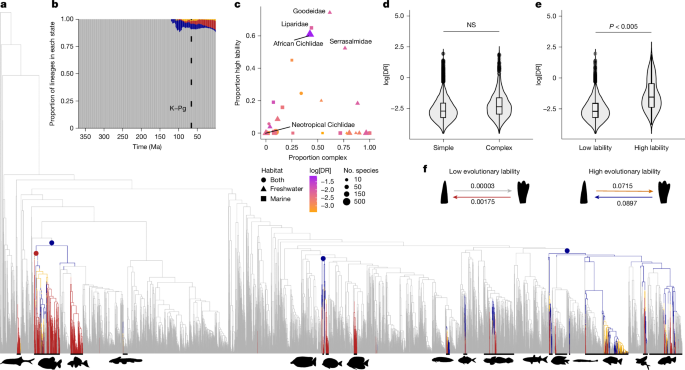Rabosky, D. L. et al. An inverse latitudinal gradient in speciation rate for marine fishes. Nature 559, 392–395 (2018).
Weir, J. T. & Schluter, D. The latitudinal gradient in recent speciation and extinction rates of birds and mammals. Science 315, 1574–1576 (2007).
Schluter, D. & Pennell, M. W. Speciation gradients and the distribution of biodiversity. Nature 546, 48–55 (2017).
Roelants, K. et al. Global patterns of diversification in the history of modern amphibians. Proc. Natl Acad. Sci. USA 104, 887–892 (2007).
Miller, A. H., Stroud, J. T. & Losos, J. B. The ecology and evolution of key innovations. Trends Ecol. Evol. 38, 122–131 (2023).
Lovette, I. J., Bermingham, E. & Ricklefs, R. E. Clade-specific morphological diversification and adaptive radiation in Hawaiian songbirds. Proc. R. Soc. Lond. B 269, 37–42 (2002).
Martin, C. H. & Wainwright, P. C. Trophic novelty is linked to exceptional rates of morphological diversification in two adaptive radiations of Cyprinodon pupfish. Evolution 65, 2197–2212 (2011).
De Alencar, L. R. V., Martins, M., Burin, G. & Quental, T. B. Arboreality constrains morphological evolution but not species diversification in vipers. Proc. R. Soc. B 284, 20171775 (2017).
Burns, M. D. & Bloom, D. D. Migratory lineages rapidly evolve larger body sizes than non-migratory relatives in ray-finned fishes. Proc. R. Soc. B 287, 20192615 (2020).
Hunter, J. P. & Jernvall, J. The hypocone as a key innovation in mammalian evolution. Proc. Natl Acad. Sci. USA 92, 10718–10722 (1995).
Lafuma, F., Corfe, I. J., Clavel, J. & Di-Poï, N. Multiple evolutionary origins and losses of tooth complexity in squamates. Nat. Commun. 12, 6001 (2021).
Luo, Z.-X. Transformation and diversification in early mammal evolution. Nature 450, 1011–1019 (2007).
Ricklefs, R. E. Global variation in the diversification rate of passerine birds. Ecology 87, 2468–2478 (2006).
Liem, K. F. Evolutionary strategies and morphological innovations: cichlid pharyngeal jaws. Syst. Zool. 22, 425–441 (1973).
Hunter, J. P. Key innovations and the ecology of macroevolution. Trends Ecol. Evol. 13, 31–36 (1998).
Rabosky, D. L. Phylogenetic tests for evolutionary innovation: the problematic link between key innovations and exceptional diversification. Phil. Trans. R. Soc. B 372, 20160417 (2017).
Miller, A. H. Ornithologie als Biologische Wissenschaft (Mayr, E. & Schuz, E., eds.) 84–88 (Carl Winter, 1949).
Title, P. O. et al. The macroevolutionary singularity of snakes. Science 383, 918–923 (2024).
Schluter, D. The Ecology of Adaptive Radiation (Oxford Univ. Press, 2000).
Carroll, S. B. Chance and necessity: the evolution of morphological complexity and diversity. Nature 409, 1102–1109 (2001).
Jackman, W. R. et al. Manipulation of Fgf and Bmp signaling in teleost fishes suggests potential pathways for the evolutionary origin of multicuspid teeth. Evol. Devel. 15, 107–118 (2013).
Wainwright, P. C. & Longo, S. J. Functional innovations and the conquest of the oceans by acanthomorph fishes. Curr. Biol. 27, R550–R557 (2017).
Wainwright, P. C., McGee, M. D., Longo, S. J. & Hernandez, L. P. Origins, innovations, and diversification of suction feeding in vertebrates. Integr. Comp. Biol. 55, 134–145 (2015).
Tebbett, S. B., Goatley, C. H. R. & Bellwood, D. R. Clarifying functional roles: algal removal by the surgeonfishes Ctenochaetus striatus and Acanthurus nigrofuscus. Coral Reefs 36, 803–813 (2017).
Berkovitz, B. & Shellis, P. The Teeth of Non-Mammalian Vertebrates (Academic, 2017).
Seehausen, O. & Wagner, C. E. Speciation in freshwater fishes. Annu. Rev. Ecol. Evol. Syst. 45, 621–651 (2014).
Höhna, S. et al. RevBayes: Bayesian phylogenetic inference using graphical models and an interactive model-specification language. Syst. Biol. 65, 726–736 (2016).
Yamanaka, A. Evolution and development of the mammalian multicuspid teeth. J. Oral Biosci. 64, 165–175 (2022).
Rabosky, D. L. et al. Rates of speciation and morphological evolution are correlated across the largest vertebrate radiation. Nat. Commun. 4, 1958 (2013).
Melo, B. F. et al. Accelerated diversification explains the exceptional species richness of tropical characoid fishes. Syst. Biol. 71, 78–92 (2021).
McGee, M. D. et al. The ecological and genomic basis of explosive adaptive radiation. Nature 586, 75–79 (2020).
Pigliucci, M. Is evolvability evolvable? Nat. Rev. Genet. 9, 75–82 (2008).
Davis, M. P., Midford, P. E. & Maddison, W. Exploring power and parameter estimation of the BiSSE method for analyzing species diversification. BMC Evol. Biol. 13, 38 (2013).
Salzburger, W., Mack, T., Verheyen, E. & Meyer, A. Out of Tanganyika: genesis, explosive speciation, key-innovations and phylogeography of the haplochromine cichlid fishes. BMC Evol. Biol. 5, 17 (2005).
Ronco, F. et al. Drivers and dynamics of a massive adaptive radiation in cichlid fishes. Nature 589, 76–81 (2021).
Meier, J. I. et al. Cycles of fusion and fission enabled rapid parallel adaptive radiations in African cichlids. Science 381, eade2833 (2023).
Brawand, D. et al. The genomic substrate for adaptive radiation in African cichlid fish. Nature 513, 375–381 (2014).
Seehausen, O. African cichlid fish: a model system in adaptive radiation research. Proc. R. Soc. B 273, 1987–1998 (2006).
Greenwood, P. H. The Haplochromine Fishes of East African Lakes: Taxonomy, Biology and Evolution (Kraus, 1981).
Crofts, S. B., Smith, S. M. & Anderson, P. S. L. Beyond description: the many facets of dental biomechanics. Integr. Comp. Biol. 60, 594–607 (2020).
Ivory, S. J. et al. Environmental change explains cichlid adaptive radiation at Lake Malawi over the past 1.2 million years. Proc. Natl Acad. Sci. USA 113, 11895–11900 (2016).
Lyons, R. P. et al. Continuous 1.3-million-year record of East African hydroclimate, and implications for patterns of evolution and biodiversity. Proc. Natl Acad. Sci. USA 112, 15568–15573 (2015).
Henao Diaz, L. F., Harmon, L. J., Sugawara, M. T. C., Miller, E. T. & Pennell, M. W. Macroevolutionary diversification rates show time dependency. Proc. Natl Acad. Sci. USA 116, 7403–7408 (2019).
Mihalitsis, M. & Bellwood, D. R. Functional groups in piscivorous fishes. Ecol. Evol. 11, 12765–12778 (2021).
Magalhaes, I. S., Lundsgaard-Hansen, B., Mwaiko, S. & Seehausen, O. Evolutionary divergence in replicate pairs of ecotypes of Lake Victoria cichlid fish. Evol. Ecol. Res. 14, 381–401 (2012).
Corn, K. A. et al. The rise of biting during the Cenozoic fueled reef fish body shape diversification. Proc. Natl Acad. Sci. USA 119, e2119828119 (2022).
Price, S. A., Hopkins, S. S. B., Smith, K. K. & Roth, V. L. Tempo of trophic evolution and its impact on mammalian diversification. Proc. Natl Acad. Sci. USA 109, 7008–7012 (2012).
Albertson, R. C. Genetic basis of adaptive shape differences in the cichlid head. J. Hered. 94, 291–301 (2003).
Duenser, A. et al. Developmental tinkering of gene regulation facilitated super rapid adaptive radiation. Preprint at bioRxiv https://doi.org/10.1101/2024.01.24.577063 (2024).
Yamanaka, A. et al. Developmental process of the modern house shrew’s molars: implications for the evolution of the tribosphenic molar in Mesozoic mammals. Evolution https://doi.org/10.1093/evolut/qpad228 (2023).
Peoples, N., Burns, M. D., Mihalitsis, M. & Wainwright, P. C. Evolutionary lability of a key innovation spurs rapid diversification. Figshare https://doi.org/10.6084/m9.figshare.25661859 (2024).
Rabosky, D. L. No substitute for real data: a cautionary note on the use of phylogenies from birth–death polytomy resolvers for downstream comparative analyses. Evolution 69, 3207–3216 (2015).
Beaulieu, J. M., O’Meara, B. C. & Donoghue, M. J. Identifying hidden rate changes in the evolution of a binary morphological character: the evolution of plant habit in campanulid angiosperms. Syst. Biol. 62, 725–737 (2013).
Boyko, J. D. & Beaulieu, J. M. Generalized hidden Markov models for phylogenetic comparative datasets. Methods Ecol. Evol. 12, 468–478 (2021).
Fabreti, L. & Höhna, S. Convergence assessment for Bayesian phylogenetic analysis using MCMC simulation. Methods Ecol. Evol. 13, 77–90 (2022).
Bollback, J. P. SIMMAP: stochastic character mapping of discrete traits on phylogenies. BMC Bioinf. 7, 88 (2006).
Tribble, C. M. et al. RevGadgets: an R package for visualizing Bayesian phylogenetic analyses from RevBayes. Methods Ecol. Evol. 13, 314–323 (2022).
Rabosky, D. L. & Goldberg, E. E. FiSSE: a simple nonparametric test for the effects of a binary character on lineage diversification rates. Evolution 71, 1432–1442 (2017).
Jetz, W., Thomas, G. H., Joy, J. B., Hartmann, K. & Mooers, A. O. The global diversity of birds in space and time. Nature 491, 444–448 (2012).
Louca, S. & Pennell, M. W. Extant timetrees are consistent with a myriad of diversification histories. Nature 580, 502–505 (2020).
Revell, L. J. phytools: an R package for phylogenetic comparative biology (and other things). Methods Ecol. Evol. 3, 217–223 (2012).
Maddison, W. P., Midford, P. E. & Otto, S. P. Estimating a binary character’s effect on speciation and extinction. Syst. Biol. 56, 701–710 (2007).
Beaulieu, J. M. & O’Meara, B. C. Detecting hidden diversification shifts in models of trait-dependent speciation and extinction. Syst. Biol. 65, 583–601 (2016).
Louca, S. & Pennell, M. W. A general and efficient algorithm for the likelihood of diversification and discrete-trait evolutionary models. Syst. Biol. 69, 545–556 (2020).
Helmstetter, A. J. et al. Trait-dependent diversification in angiosperms: patterns, models, and data. Ecol. Lett. 26, 640–657 (2023).
Paradis, E. & Schliep, K. ape 5.0: an environment for modern phylogenetics and evolutionary analyses in R. Bioinformatics 35, 526–528 (2019).
Zenil-Ferguson, R., McEntee, J. P., Burleigh, J. G. & Duckworth, R. A. Linking ecological specialization to its macroevolutionary consequences: an example with passerine nest type. Syst. Biol. 72, 294–306 (2023).
Froese, R. & Pauly, D. FishBase www.fishbase.org (2024).
Pagel, M. Detecting correlated evolution on phylogenies: a general method for the comparative analysis of discrete characters. Proc. R. Soc. Lond. B 255, 37–45 (1994).


